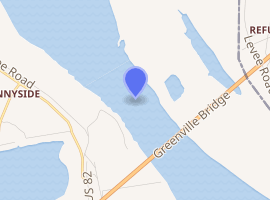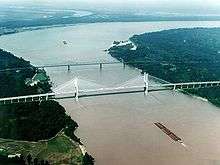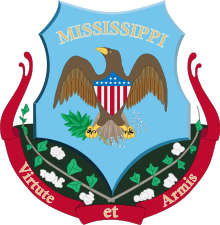Benjamin G. Humphreys Bridge
The Benjamin G. Humphreys Bridge was a two-lane cantilevered truss bridge carrying U.S. Route 82/U.S. Route 278 across the Mississippi River between Lake Village, Arkansas and Greenville, Mississippi. It was the first bridge to connect the two towns. The bridge was named for Benjamin G. Humphreys II, a former United States Congressman from Greenville.
Benjamin G. Humphreys Bridge | |
|---|---|
 A photo of the bridge taken from the Arkansas side. | |
| Coordinates | 33°17′37″N 91°09′34″W |
| Carries | Formerly 2 lanes of |
| Crosses | Mississippi River |
| Locale | Lake Village, Arkansas and Greenville, Mississippi |
| ID number | 0000000000M1536 |
| Characteristics | |
| Design | Cantilever bridge |
| Total length | 9,957 feet (3,035 m) |
| Width | 24 feet (7 m) |
| Longest span | 840 feet (256 m) |
| Clearance below | 130 feet (40 m) |
| History | |
| Opened | October 4, 1940 |
| Closed | July 28, 2010 |

| |
Hailed as progressive when it opened in 1940, it became functionally obsolete as vehicle and river traffic increased. Because of its narrow two lanes with no shoulders, the bridge often became blocked by accidents or by the crossing of large vehicles like farm equipment. Due to its location near a sharp bend in the Mississippi River, the bridge became a hazard to river traffic; barges and towboats frequently collided with it. In 1994, a study concluded that a new bridge was needed and the old one should be torn down.[1]
In 2010, a new bridge, the Greenville Bridge, was opened as a replacement further downriver from the sharp bend. In 2011, work began to remove the Benjamin G. Humphreys Bridge.
Description
The Benjamin G. Humphreys Bridge, very modern in its time, was a two lane, steel cantilevered truss bridge that carried US 82/278 over the Mississippi River, and connected the towns of Lake Village, Arkansas and Greenville, Mississippi by road for the first time. Prior to the bridge, local vehicles and local freight could only cross the river by ferry.[2] It was named after Benjamin G. Humphreys, a US Congressman from Greensville who co-authored a flood control bill in 1917 establishing a national flood control program on the Mississippi and promoted the concept of flood control to contain the river.[3]
The bridge opened on October 4, 1940 to great fanfare.[3] Its main span width was 840 feet (260 m), the highway bridge with the longest span on the Mississippi River. The width of the roadway was 24 feet (7.3 m)—two lanes of 12 feet (3.7 m) each with no shoulders.[4]
Both the original bridge and its replacement are geographically mostly in Arkansas, as the state lines were determined prior to the shift west of the Mississippi River.
History
In the late 1930s, talk started on the construction of a bridge to cross the Mississippi River at Greenville. In 1936, a group called the Arkansas-Mississippi-Alabama US 82 Association was formed to raise funds for the bridge. In 1937, Milton C. Smith (the mayor at that time) worked with John A. Fox, (the secretary of the Washington County Chamber of Commerce), to get Congress to pass a law authorizing the bridge. The bill authorizing the bridge was signed into law in August 1937 by President Franklin D. Roosevelt. In 1938, Smith applied for money from the Works Progress Administration to fund the estimated $4.5 million it would take to build the bridge. The Works Progress Administration agreed to the proposal in September 1938 and construction started on the bridge a few months later.[5]

The Benjamin G. Humphreys Bridge was built by the company now known as HNTB and opened to much fanfare in 1940 as the "pathway to progress" for the Mississippi Delta.[6] It was a through-truss design and had a span of 840 feet (256 meters). Until 1943, this was the longest bridge for vehicles on the Mississippi River.[7] Over time, the bridge supported increasing volumes of highway traffic and vehicles hitting the bridge. In the 1950s, an Air Force plane crashed into the bridge. Though the bridge remained structurally sound, it was becoming functionally obsolete.[4] It had only two narrow highway lanes and no shoulders. An accident or the crossing of very large vehicles such as a large combine could force the bridge to close.[6]
With river traffic increasing, damage from barge collisions increased. By 1972, the Greenville Bridge was hit more times by barges than any other bridge on the Mississippi. The bridge was located close to a sharp bend in the Mississippi; towboats and barges had difficulty making the sharp turn and regaining their course in time to avoid a collision with the bridge. Over the years many have not been able to make the turn quickly and have hit it. The bridge had become a danger to river traffic.[6]
A 1994 engineering study by the Mississippi Department of Transportation explored alternatives to upgrading the crossing of US 82 and issued a report that explored a four-lane crossing at Greenville. It concluded the best of several alternatives it identified was to build a new bridge 0.5 miles (0.80 km) downriver from the old one and to remove the old bridge. Additional studies evaluated the type of bridge to build, and by 1995 the cable-stayed bridge was chosen as the best design to fit the river and soil conditions, as well as providing sufficient clearance for river navigation. Engineering plans were completed in 1999 for the Greenville Bridge, its replacement.[4]
Destruction
The new Greenville Bridge opened to traffic on August 4, 2010.[6] In 2011 the massive process of removing the old bridge by cutting into small sections to be recycled was begun and was completed in September 2012.[8] At times the river was closed to traffic to aid the demolition.[9] The job was dangerous and two workers died during the demolition.[10]
See also




- List of crossings of the Lower Mississippi River
References
- "The Quest for a Bridge". US 82 Greenville Bridge. Archived from the original on October 30, 2013. Retrieved April 12, 2014.
- "The Quest for a Bridge". US 82 Greensville Bridge. Archived from the original on October 30, 2013. Retrieved January 12, 2012.
- "The Quest for a Bridge - Part 3". The Quest for a Bridge. US 82 Greensville Bridge. Archived from the original on August 19, 2008. Retrieved January 13, 2012.
- "Project Summary: The New Bridge". US 82 Greenville Bridge. Archived from the original on May 18, 2012. Retrieved January 12, 2012.
- "The Quest for a Bridge - Part 2". US 82 Greensville Bridge. Archived from the original on August 7, 2008. Retrieved January 12, 2012.
- Lampkin, Sheilla (February 17, 2011). "End of an Era: Greenville Bridge Dismantled". Monticello Live. Retrieved January 12, 2012.
- "Project Summary: The 1940 Bridge". US 82 Greenville Bridge. Archived from the original on November 7, 2011. Retrieved January 12, 2012.
- "Project Updates for District 3 (Delta Region)". Mississippi Department of Transportation. March 30, 2010. Archived from the original on August 17, 2011. Retrieved January 11, 2012.
- "Regulated Navigation Area; Greenville Bridge Demolition, Lower Mississippi River Mile 531.3, AR, MS". November 2, 2010. Federal Register. Retrieved January 11, 2012.
- Associated Press (March 11, 2011). "Two workers die in Greenville Bridge accident". Mississippi Business Journal. Retrieved January 6, 2012.
External links
| Wikimedia Commons has media related to Benjamin G. Humphreys Bridge. |